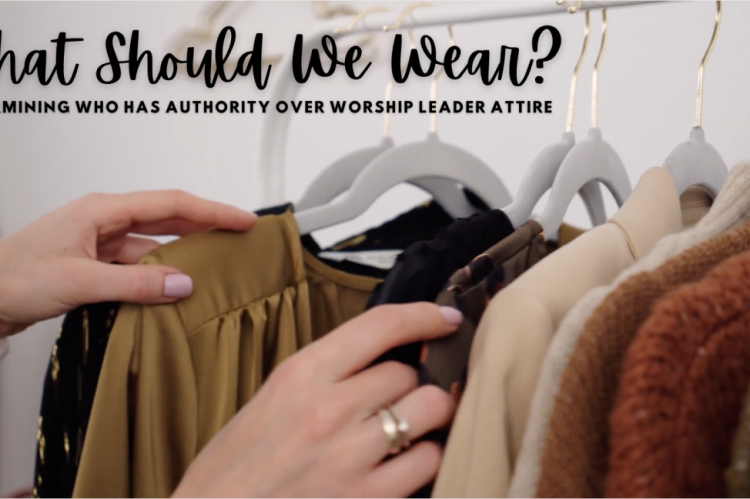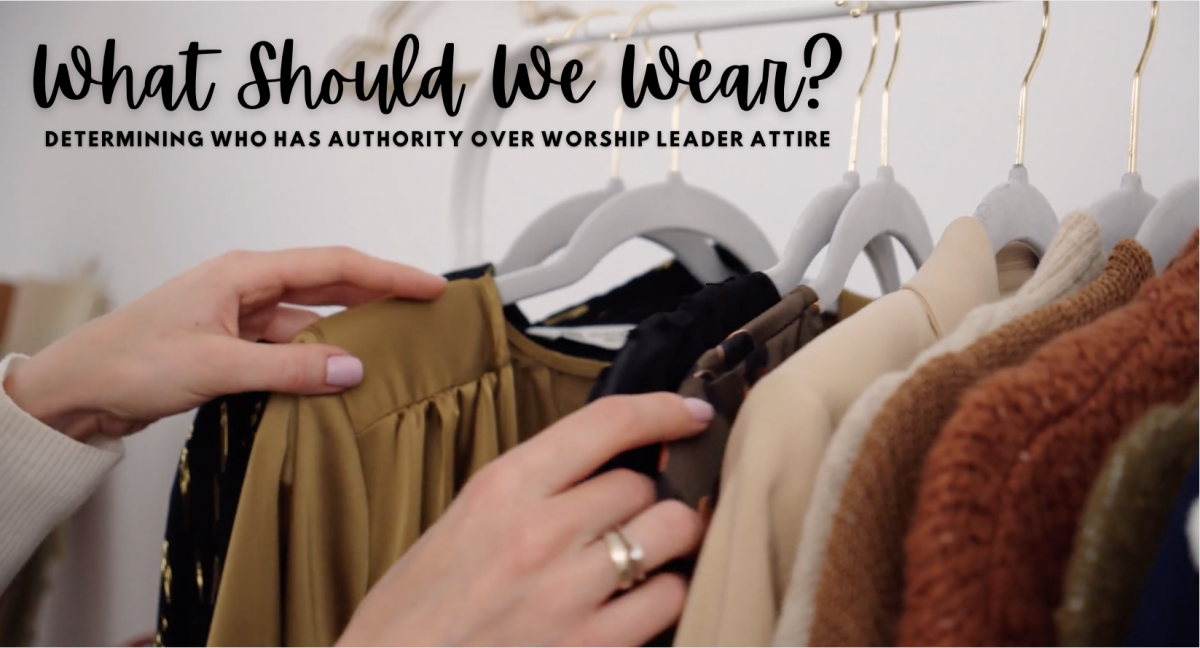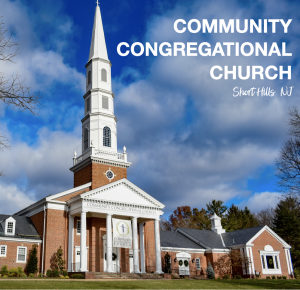What Should She Wear?
She stands in her closet on a Sunday morning, thinking about what she should wear to lead worship that day. As she rifles through the hangers, she thinks to herself, “Is this skirt too short? Will I be able to cross my legs?” Then she remembers that she’ll need to sit on the chancel steps with the children, so a skirt probably isn’t a good idea.
Pants. She should wear pants. Leggings aren’t an option; they’re too tight. Pixie-style ponte pants would work, but she considers if they’re too trendy for her conservative congregation. Since they’re form-fitting, she chooses a top that’s long enough to cover her backside. Lastly, shoes – flats or heels? Heels look better with this outfit but could be seen as too sexy. She goes with the flats.
As she steps out of her closet, she wonders whether the colors are too flashy, if the style reflects who she is (while not being too far removed from her congregation’s attire), and whether her outfit will be considered too casual or unprofessional in comparison with her male colleague’s typical suit-without-a-tie. Does this outfit reflect the vision of her church? Does she feel like herself in these clothes? Do they reflect her status and function as a pastor leading worship?
Her Sunday mornings were simpler when she wore a robe, yet choosing her own clothing reveals her personality to her congregation and allows her to be more authentic in her leadership. And still, after all of this, the real focus of the day has yet to begin – leading worship! She wonders if what she has chosen to wear will facilitate this or if it will serve as a distraction. And she wonders what factors should be considered when choosing clothing for worship, and who ultimately has the authority to determine those factors. What should she wear?
Why should I think about what I wear to lead worship?
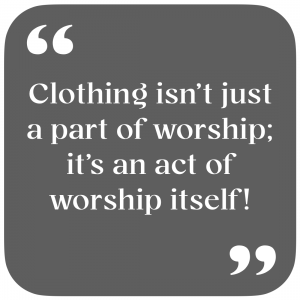 Because, simply put, clothing isn’t just a part of worship – it’s an act of worship itself! As worship leaders, we function as mediators of God’s voice, and our clothing participates as a communicator of the Gospel message.
Because, simply put, clothing isn’t just a part of worship – it’s an act of worship itself! As worship leaders, we function as mediators of God’s voice, and our clothing participates as a communicator of the Gospel message.
The potential for authentic worship can be significantly impacted by something as simple as the leader’s clothing. It can (1) blend in and disappear, allowing the worship leader’s words to be the primary mode of communication, (2) facilitate worship by creating a sense of identification with the worship leader, or (3) be a distraction from the message of the Gospel and the experience of authentic worship.
As worship leaders, we need to make informed and intentional choices that reflect the function of our office as worship leader and are representative of our church, while honoring our personal identity and the image we wish to project about ourselves through our clothing.
So…how do I choose what to wear?
When my congregation, Community Congregational Church in Short Hills, NJ, made the decision to change our worship from “traditional” to “contemporary” as part of a new vision for the congregation, robes were no longer considered part of that vision. As the only female pastor on staff, I faced a dilemma unique to women in pastoral leadership roles: how do I decide what is appropriate to wear to lead worship, given the complexity of women’s clothing?
I had to consider how I would reflect my personality, claim my role as a pastor, and embrace the vision of the congregation, all without distracting from the Gospel message. The process of deciding what to wear brought up important conversations with the church leadership, including who has the right to decide what I wear and the factors that we should consider in making this decision.
To address these questions, I developed five considerations that clergy and their churches need to consider when choosing what is worn to lead worship. In no particular order:
- Contextual: “What are the pertinent characteristics of the church, its location, and its members?”
- Personal: “What do I prefer to wear?” and “What is appropriate for my body type?”
- Purpose: “What is my role, status, and function as a clergywoman and worship leader?”
- Seasonal: “What is the weather?” and “What is the season of the church year?”
- Vision: “What is the mission that this church has discerned?” and “What image is the church seeking to project about themselves?”
Who gets to decide what I wear? Me or the church leadership?
As part of my research, I conducted a survey of clergywomen, which resulted in over 1400 responses in a short 42 hours. One of the most significant results was a discrepancy between the personal prerogative of clergywomen to choose what they wear and the vision of the church.
An impressive 90% of responders said that they, rather than the church leadership, have the authority to determine what they wear to lead worship. In fact, an emphasis on the worship leader’s Purpose & Personal preferences far outweighed the other considerations, accounting for 65% of responses for the most important factor when choosing clothing for worship. Vision ranked as the least important of the considerations with only 5% of responses.
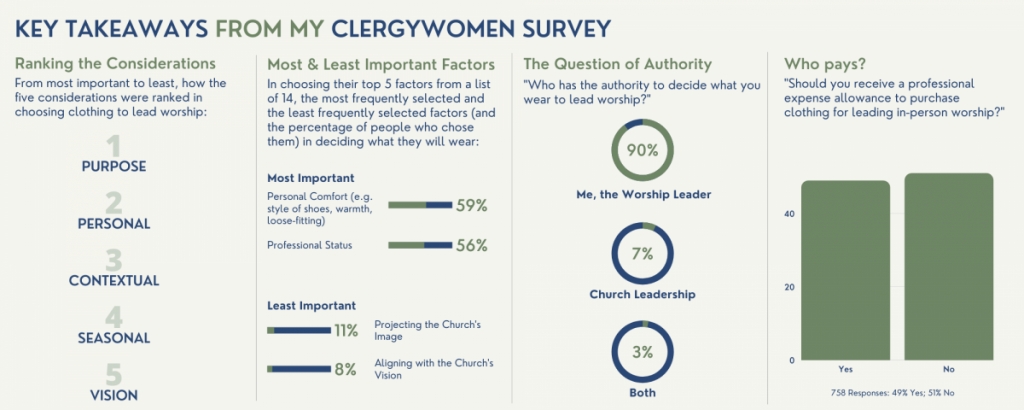
For more information about the survey and results, contact Jennifer [dot] Hrynyk [at] emory [dot] edu.
Why should I care about the church’s vision when deciding what I’ll wear?
Vision for a church community goes beyond calling itself a friendly, Christ-centered church. All churches want to be that! Vision is the intentional process of determining who a church is and why the church exists. It is the “guiding force, a controlling assumption, a directing conviction behind everything that happens.”[1]
Having and living into a vision is vital to the identity of a church. It not only provides the marching orders for a church’s identity and ministry, but it is the vehicle through which transformation happens. Rick Barger writes, “Vision is the ability to see things not as they are but as they can be…The task of congregations today who desire…to be the transformational movement birthed by God’s Spirit is first to see alternative ways of being.”[2] It is through an intentionally crafted vision that transformation happens, both for individuals and for the world.[3]
So what’s the bottom line?
Aligning a church’s vision with the practices of what we wear to lead worship is vital to the future of the church. When leaders choose their own preferences over the vision embraced by a church, the church is at risk of losing the very basis of its identity, as called by God.
Churches (and their pastors) much reclaim their vision in service of facilitating transformation – of individuals and of the world – by living into that mission. Pastors have a responsibility to lay down (or, at the very least, balance) their personal preferences in service of the vision of the church and the calling of God – including, and especially, in choosing the clothes they wear to lead worship.
RESOURCES
→ Gender Issues & Leading Worship
- McCullough, Amy P. Her Preaching Body: Conversations about Identity, Agency, and Embodiment among Contemporary Female Preachers. Eugene, OR: Cascade Books, 2018.
- Long, Kimberly Bracken. The Worshiping Body: The Art of Leading Worship. 1st ed. Louisville, KY: Westminster John Knox Press, 2009.
→ Conversations about Culture
- Kim, Matthew D. Preaching with Cultural Intelligence: Understanding the People Who Hear Our Sermons. Grand Rapids: Baker Academic, 2017.
→ The Importance of Vision
- Piazza, Michael, and Cameron Trimble. Liberating Hope: Daring to Renew the Mainline Church. Cleveland, OH: The Pilgrim Press, 2011.
- Warren, Rick. The Purpose Driven Church: Growth without Compromising Your Message & Mission. Grand Rapids, MI: Zondervan Pub., 2011.
NOTES
[1] Rick Warren, The Purpose Driven Church: Growth without Compromising Your Message & Mission, (Grand Rapids, MI: Zondervan Pub., 2011), 77.
[2] Rick Barger, A New and Right Spirit: Creating An Authentic Church in a Consumer Culture, (Lanham, MD: Rowman & Littlefield Publishers, 2005), 113-114.
[3] Piazza expands on this concept of crafting a vision and suggests that the following four questions must be answered: “Who are we (individually and as a collective group)? What needs in our community are we seeking to meet? What values do we honor and allow to shape us? How would this community be positively changed through our presence?” (Michael Piazza and Cameron Trimble. Liberating Hope: Daring to Renew the Mainline Church, (Cleveland, OH: The Pilgrim Press, 2011), 33.)
The Rev. Dr. Jennifer Testa Hrynyk has been a pastor at Community Congregational Church in Short Hills, NJ for over 15 years. She holds a Doctor of Ministry from Candler School of Theology at Emory University and a Masters of Divinity from Princeton Theological Seminary. To get in touch with Jennifer, contact Jennifer [dot] Hrynyk [at] emory [dot] edu.
